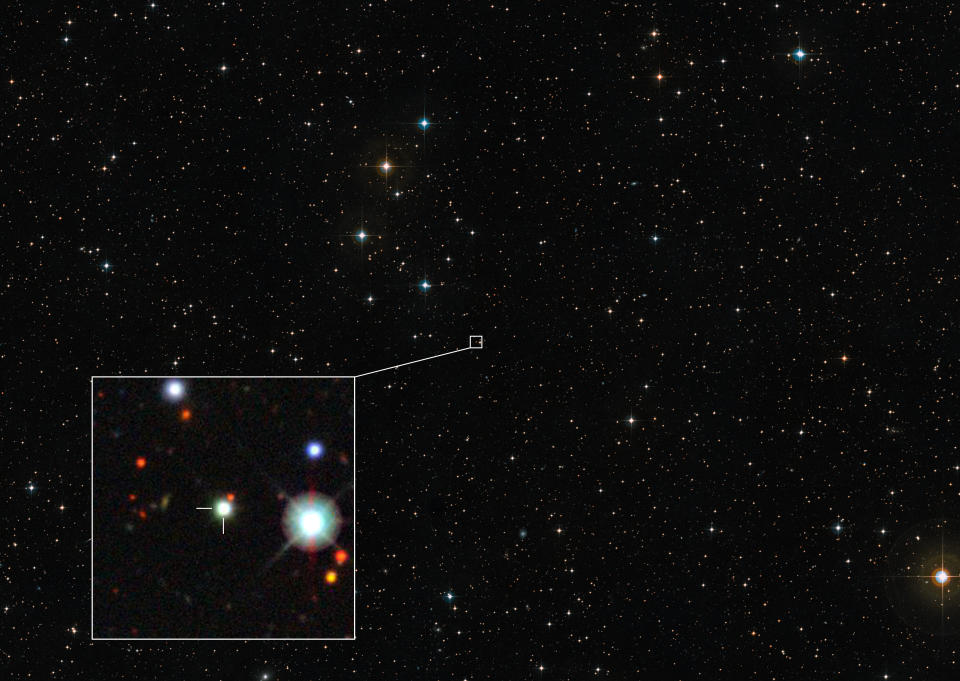A newly discovered quasar is a real record breaker. It is not only the brightest quasar ever seen, but also the brightest astronomical object ever seen. It’s also powered by the hungriest and fastest-growing black hole ever seen – a hole that consumes the equivalent of more than one solar mass per day.
The quasar, J0529-4351, is so far from Earth that its light has taken 12 billion years to reach us, meaning it is seen as it was when the 13.8 billion year old universe was just under was 2 billion years old.
The supermassive black hole at the heart of the quasar is estimated to be between 17 billion and 19 billion times the mass of the Sun; every year it eats gas and dust equivalent to a mass of 370 solar masses. This makes J0529-4351 so luminous that if it were placed next to the Sun, it would be 500 trillion times brighter than our brilliant star.
“We have discovered the fastest growing black hole known to date. It has a mass of 17 billion suns and eats just over one sun per day,” team leader and astronomer Christian Wolf of the Australian National University said in a statement. “This makes it the most luminous object in the known universe.”
J0529-4351 was spotted in data more than four decades ago, but was so bright that astronomers failed to identify it as a quasar.
Related: Event Horizon Telescope spies on fighter jets erupting from a nearby supermassive black hole
How a quasar fooled astronomers for 44 years
Quasars are regions at the heart of galaxies that house supermassive black holes, surrounded by the gas and dust that these cavities feed on. The violent conditions in the disks of matter surrounding such active black holes, called accretion disks and generated by the objects’ immense gravity, heat the gas and dust and cause it to glow brightly.
Furthermore, any matter in these disks that is not absorbed by a black hole is channeled to the poles of the cosmic titan, where it is blown out as a jet of particles at nearly the speed of light, also generating powerful light. As a result, quasars in these active galactic nuclei (AGN) can shine brighter than the combined light of billions of stars in the galaxies around them.
But even among these exceptionally bright events, J0529-4351 stands out.
The light from J0529-4351 comes from the massive accretion disk that feeds the supermassive black hole, which the team estimates is about 7 light-years in diameter. That means that passing through this accretion disk would be equivalent to traveling between Earth and the Sun about 45,000 times.


“It’s a surprise that it has remained unknown to this day, when we already know of about a million less impressive quasars. It has literally been staring us in the face until now,” said team member and scientist from the Australian National University , Christopher Onken, in the position.
J0529-4351 was first spotted in the Schmidt Southern Sky Survey, dating back to 1980, but it took decades before it was confirmed to be a quasar. Major astronomical surveys produce so much data that astronomers need machine learning models to analyze it and sort quasars from other celestial bodies.
These models are also trained using currently discovered objects, which may cause them to miss candidates with exceptional properties such as J0529-4351. In fact, this quasar is so bright that models passed it by, assuming it was a star relatively close to Earth.
This misclassification was noticed in 2023, when astronomers realized that J0529-4351 is in fact a quasar after looking at the object’s region with the 2.3-meter telescope at the Siding Spring Observatory in Australia.
The new discovery that this is actually the brightest quasar ever was created when the X-shooter spectrograph instrument of the Very Large Telescope (VLT) in the Atacama Desert of northern Chile succeeded J0529-4351.
RELATED STORIES:
— The giant black hole of galaxy M87 shoots jets at almost the speed of light
— A vampire’s black hole is a ‘cosmic particle accelerator’ that could solve a long-standing astronomical mystery
– The first black hole ever imaged by humans has warped magnetic fields and scientists are excited
Astronomers aren’t done with J0529-4351 yet.
The team thinks the supermassive black hole at the heart of this quasar is feeding near the Eddington limit, or the point at which the radiation it emits should push away gas and dust, closing off this black hole’s cosmic storehouse.
Further detailed research will be required to confirm this. Fortunately, however, the greedy supermassive black hole is the perfect target for an upgraded GRAVITY+ instrument from the VLT, which will improve high-contrast precision on bright objects.
J0529-4351 will also be examined by the upcoming Extremely Large Telescope (ELT), currently under construction in the Atacama Desert.
However, it is the thrill of finding something new and exciting that drives the leader of the team behind this record-breaking discovery.
“Personally, I just love the chase. A few minutes a day I feel like a kid again, treasure hunting, and now I bring to the table everything I’ve learned since then,” Wolf concluded.
The team’s research was published Monday (Feb. 19) in the journal Nature Astronomy.